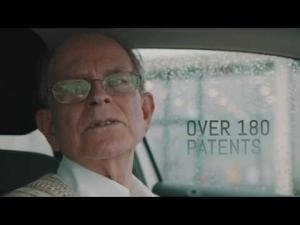Anton van Zanten
Electronic stability control for cars
Winner of the European Inventor Award 2016
Van Zanten's electronic guidance technology, which went into serial production in 1995, solved a long-standing problem in vehicle safety: when drivers "slam" on the breaks - for instance to avoid a suddenly occurring obstacle - the wheels "lock up" and sideways forces send the car veering off the road, often with fatal consequences. In these situations, van Zanten's electronic stability control system (ESC) springs into action, balancing the car within a hundredth of a second, faster than a human could ever hope to respond.
As the head of a 35-strong development group at Bosch, van Zanten achieved his breakthrough in 1987 by running tests on vehicles and turning to the power of computers. Based on real-time feedback from on-board sensors, ESC quickly compensates for imbalances in a car's sideways forces - called lateral dynamics - in dangerous situations such as aquaplaning, or breaking on snow or ice. Since its introduction, the technology has saved thousands of lives as a vital automotive safety technology on a par with the seatbelt and airbag.
Societal benefit
According to the World Health Organisation, traffic accidents kill around 1.25 million people worldwide each year - significantly more than murders and military conflicts, with their combined annual toll of 440 000 deaths. ESC significantly reduces the high risk of a fatal outcome to sliding off the road. Studies cited by Bosch maintain that van Zanten's invention can prevent up to 80% of automotive accidents related to skidding off the road, and that since its launch it has prevented 260 000 accidents and saved some 8 500 lives in Europe alone.
The winner of over 110 industry awards, ESC's success is most apparent in the accidents it prevents. The US National Highways Traffic Safety Administration (NHTSA) has calculated that ESC prevents 34% of all vehicle accidents and 70% of possible fatal vehicle rollovers. According to the NHTSA, it thus prevents just under a third of what would otherwise be fatal traffic accidents, saving tens of thousands of lives since its introduction. This makes ESC the single most important vehicle safety system after the seatbelt.
Economic benefit
In 1995, the technology was first deployed in a production vehicle, the S-Class limousine made by German automotive company Mercedes-Benz. Between its commercial launch in 1995 and 2010, Bosch reportedly sold 52 million ESC systems, well before the system became mandatory for all new European cars in 2014. As at 2016, Bosch has manufactured more than 150 million ESC/ESP systems. The safety system is now required in the EU for all newly registered cars and light commercial vehicles weighing up to 3.5 tonnes. Across Europe, 90% of all cars and light commercial vehicles are equipped with ESC.
The latest industry forecasts by Research and Markets suggest that the market for ESC will grow at a compound annual growth rate of 10.9% in the coming years to reach EUR 38.4 billion (USD 42 billion) in 2019. By preventing crashes in the first place, the ESC system is of even greater economic benefit than seat belts and airbags, which only reduce crash-related injuries. It not only helps reduce financial damage from crashes but also traffic congestion, which causes indirect costs through, for example, wasted petrol and tim
How it works
During normal driving, the electronic stability control system (ESC) runs quietly in the background, constantly comparing the driver's intended direction and the vehicle's actual course. The system obtains critical data such as wheel alignment, acceleration and surface contact through sensors placed across the vehicle. These factors are evaluated in a central on‑board computer, called electronic control unit (ECU), by a combination of microprocessors and proprietary software.
In dangerous situations, such as loss of steering control or road traction, ESC compensates for imbalances by automatically applying hydraulic brakes to all four wheels individually. This fine‑tuned braking response prevents "locking" of wheels during breaking manoeuvres and saves the car from rolling over and veering off the road.
The inventor
Van Zanten began pondering the future of automotive safety systems while doing his doctorate at Cornell University in 1973. Upon joining German engineering firm Robert Bosch in 1977, the engineer was part of a team working on the anti-lock braking system (ABS) that paved the way for successful testing of ESC in 1987. Computers at the time were so large that the prototype vehicle was a Mercedes estate car filled to the brim with electronics, which van Zanten nevertheless drove himself over icy roads on test runs, confident of his technology.
During a career in automotive safety technologies spanning over 40 years, van Zanten has authored some 180 granted patent families - 36 relating to automotive safety - with tremendous market impact. Follow-up inventions to ABS and ESC include rollover mitigation (ROM), trailer sway mitigation (TSM) and the secondary collision mitigation (SCM) system that automatically applies brakes to all four wheels once a vehicle has been involved in a collision. Retired since 2003, he now lectures on vehicle systems at several universities and acts as a consultant for leading automotive companies.
For his contributions to automotive safety, van Zanten has received numerous awards, including the Henry Ford II Distinguished Award for Excellence in Automotive Engineering (1995), the Ferdinand Porsche Prize (1999) and the IFAC Industrial Achievement Award (2011).
Did you know?
ESC, in part, owes its jump-start to a major marketing "crash" in 1997. Mercedes-Benz A-Class vehicles flipped over at 78 km/h in Swedish Teknikens Värld magazine's "Elk test", a rigorous evasive manoeuvre test that simulates wildlife rushing the road. With media criticism in overdrive, the German car maker needed to steer its safety image back on track, and fast.
Having already gone into serial production of ESC in 1995, Mercedes-Benz recalled and retrofitted 130 000 A-Class vehicles with the anti-swerve safety system - and passed the test.
Extensive media coverage provided the market traction that would help ESC emerge as the global industry standard it is today.
Media gallery
Contact
European Inventor Award and Young Inventors Prize queries:
european-inventor@epo.org Subscribe to the European Inventor Award newsletterMedia-related queries:
Contact our Press team#InventorAward #YoungInventors












